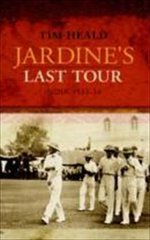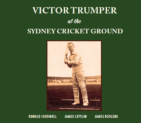Jardine’s Last Tour
Martin Chandler |Published: 2011
Pages: 140
Author: Heald, Tim
Publisher: Methuen
Rating: 3 stars

Once the ramifications of the famous Bodyline series of 1932/33 had, in the following county season, worked their way through the game, Douglas Jardine became something of a Pariah as far as the English cricketing establishment was concerned. An intensely proud man, on seeing the writing on the wall Jardine simply walked away. His career in First Class cricket had ended, at the age of just 33, by the time Australia arrived for the next Ashes series in 1934.
Knowing what we do of Jardine’s personality it would doubtless amuse him to know that, almost eighty years on from his team’s triumphant march through Australia, and more than half a century after his death, his reputation has been rehabilitated and he and his cricketing legacy have now taken their rightful place amongst the great and the good of the game’s past.
There were just two more cricketing adventures for Jardine after his return from Australia in 1933. The first was that summer’s Test series against West Indies, during which he demonstrated to anyone who cared to learn just how fast leg theory bowling should be played. Thereafter his final act as captain of England was to take a second string side to the country of his birth, India, for the first Test series ever played on the sub-continent, during the winter of 1933/34. It is that tour that Jardine’s Last Tour concerns itself with.
The trip is not a well known one, and no English journalist or writer accompanied the touring party. There was no contemporary account published and, in reality, no one in England has taken a great deal of interest in it until now. In the circumstances it is no surprise that Tim Heald’s source material originates, in the main, from Indian writings, and that he has not uncovered very much that is new about any of the characters involved.
On the plus side the book is very well written, and for anyone seeking a basic understanding of how Indian society functioned in the 1930s, it is a worthwhile read. That said a reader who wants to learn more about Jardine will acquire no knowledge here that he or she cannot pick up from Christopher Douglas’ excellent biography, and there is also little to learn about the actual play, the techniques of the Indian players or the thoughts and opinions of those involved in the tour, whether they be players, organisers or simply those who watched.
In some ways it is surprising that one of the bigger publishing houses has produced this at all, although given that thanks to Methuen a second edition of Douglas’ book appeared in 2002, as well as a third edition of Jardine’s own book on the 1932/33 tour in 2005, perhaps there is just someone there who is fascinated by the era. Whatever the reason I am afraid I cannot foresee a bestseller. At a penny shy of GBP17 for a mere 30,000 words I suspect that few other than the hardened collector or Bodyline enthusiast will bother with Jardine’s Last Tour, but kudos to Methuen for publishing it nonetheless. Perhaps next time they should think about an account of Jardine’s brief legal career – if they want to commission someone to write it they can contact me via the email address on the front page.






Leave a comment